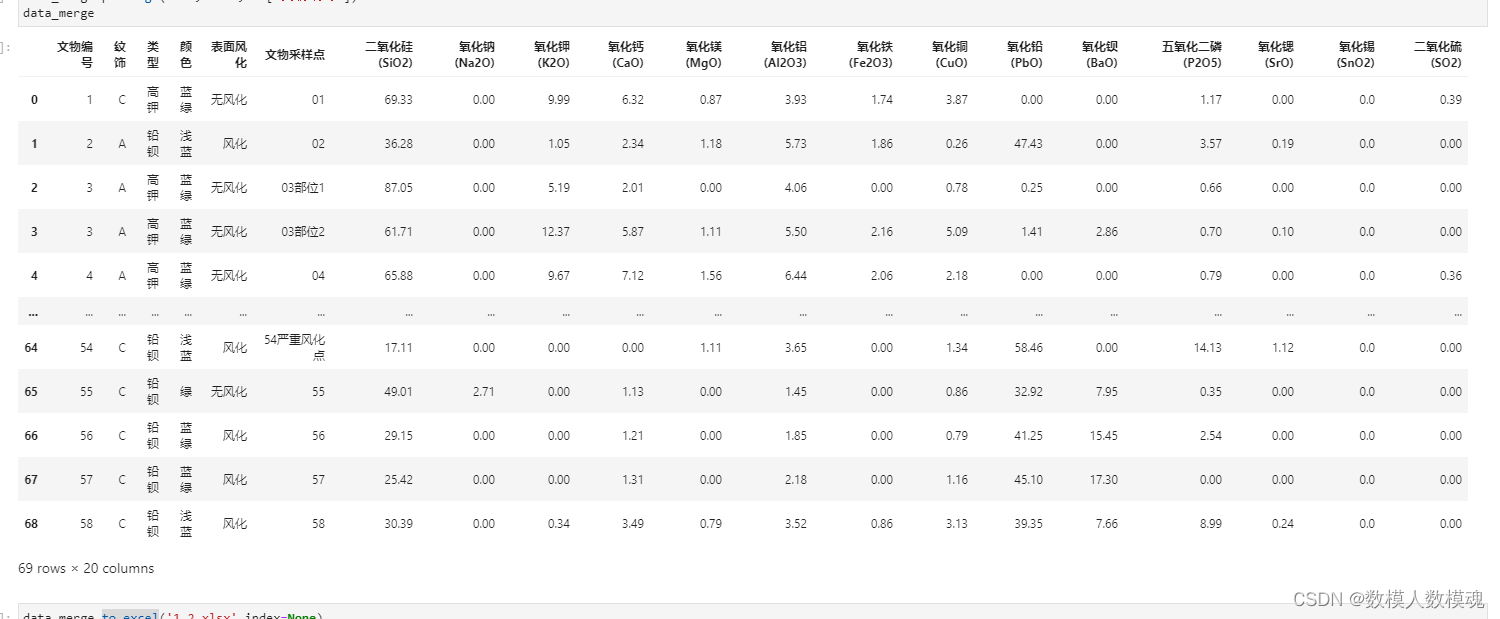C. Composition analysis and identification of ancient glass products

Question 1: Analyze the relationship between the surface weathering of these glass cultural relics and its glass type, decoration and color;
The type of glass, analyze the statistical law of weathered chemical composition content on the surface of cultural relic samples, and predict the weathering point according to the detection data
Measure its chemical composition content before weathering.
Ideas:

Break down the problem:
Question (1): Analyze the relationship between the decoration, type, color, and surface weathering of these glass cultural relics;
this question is very simple, and the analysis relationship includes correlation analysis and difference analysis. It should be noted that these four indicators are all categorical variables. It is not a continuous variable, so:
for correlation analysis, Pearson correlation analysis cannot be used directly, Spearman correlation coefficient analysis (Spearman correlation coefficient)
can be used for difference analysis, variance analysis or T test cannot be used, chi square test should be used Question (2): Based on the types of these glass cultural relics, analyze the statistical laws of whether there are weathered chemical components on the surface
of cultural relic samples ;
there are only two types, one is high potassium, and the other is lead and barium . After finishing the missing value processing, we can compare some statistical laws of the weathered chemical composition on the surface of the cultural relic samples. This is actually a difference analysis and correlation analysis, but before doing these two analyzes, we can Do some data aggregation or classification and summary, observe and infer the weathering of the two types of glass cultural relics and the difference in composition or related conditions, and then infer statistical laws and form formulas.
Question (3): Based on the weathering point detection data, predict the chemical composition content before weathering.
According to the correlation relationship obtained in question 2, the formula is formed to predict the chemical composition content of the weathered cultural relics before weathering


Question 2 : Analyze the classification rules of high-potassium glass and lead-barium glass according to the attached data; select the appropriate chemical for each category
The subcategories of the academic components are given, the specific division methods and division results are given, and the rationality and sensitivity of the classification results are given.
for analysis.
Decomposition problem:
Problem (1): Analyze the classification rules of high-potassium glass and lead-barium glass;
construct an interpretable machine learning classification model, such as decision tree, logistic regression, with type (high-potassium glass, lead-barium glass) as Y , construct as many features X as possible to form an interpretable classification rule. The key to scoring points is whether the model optimization is good or not and the visualization effect.
Question (2): For each category, select the appropriate chemical composition to divide it into subcategories, and give the specific division method and division results; perform clustering models on the categories separately, and the key to scoring points lies in the interpretability of subcategories and split effects.

Question (3): Analyze the rationality and sensitivity of the classification results.
The rationality of the classification results should be placed in the question (2), and it is ok to directly evaluate the evaluation index of the quantified clustering effect. The focus here is to adjust the model parameters used earlier and analyze the sensitivity of the model. sex
Question 3 analyzes the chemical composition of unknown glass cultural relics in the attached form 3, identifies its type, and analyzes the sensitivity of the classification results.
Question (1): Analyze the chemical composition of the unknown glass relics in the attached form 3 to identify their type;
based on question 2, predict the type of the unknown glass relics in Form 3. As for the chemical composition analysis, it is not a key
issue (2 ): To analyze the sensitivity of the classification results.
If we are using a machine learning model, then this step does not need to be analyzed. Machine learning only needs to analyze the sensitivity during training. The model has been fixed during prediction and there is no need for sensitivity analysis . However, if we do it by inference If you want to analyze it, then you need to reproduce the sensitivity analysis here

Question 4 Aiming at different types of glass cultural relic samples, analyze the relationship between their chemical components, and compare the
The differences in the chemical composition correlation between different species.
Question (1): For different types of glass cultural relic samples, analyze the relationship between their chemical components is
similar to question (2) of question 1, except that one condition is reduced - whether there is weathering
. Question (2): Compare different categories Differences in the relationship between chemical components.
